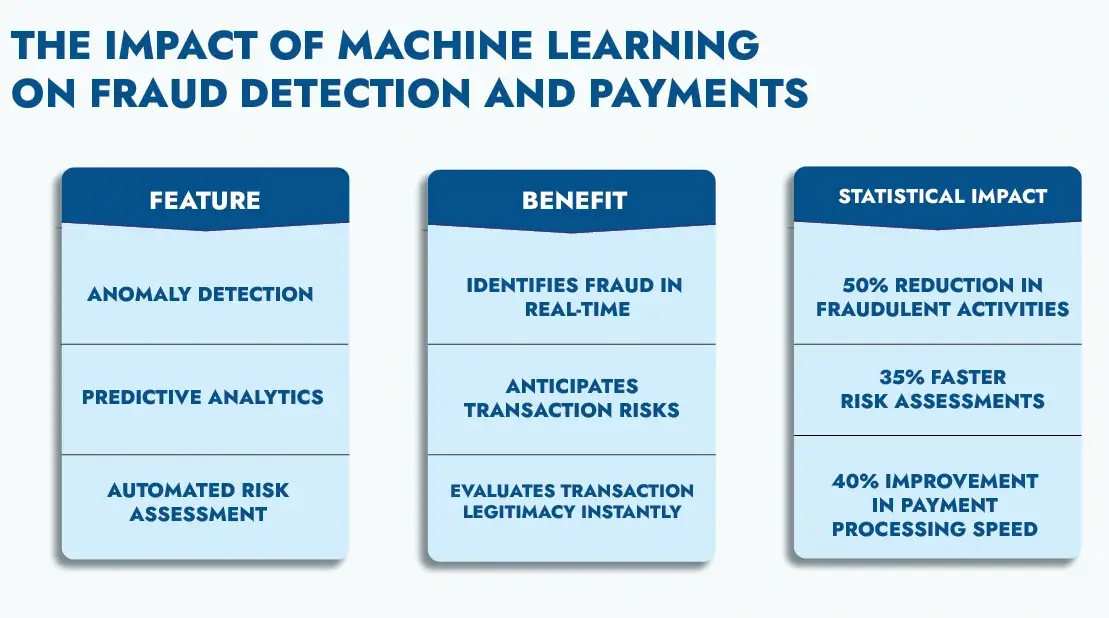







In today’s fast-moving world, waiting even a few extra seconds for a payment to process can feel like an eternity. Businesses and customers alike expect fast, secure, and seamless payment experiences. Machine learning (ML) is stepping in to revolutionize how we handle transactions, turning frustrating bottlenecks into smooth processes. Let’s explore how ML makes payments smarter and more efficient, ensuring every transaction is a win for everyone involved.
Imagine making an online purchase and instantly receiving confirmation without worrying about fraud. That’s the magic of machine learning. Behind the scenes, ML models analyze countless factors—like where the transaction is happening, the device being used, and even the buyer’s purchase history—all in the blink of an eye. If something seems off, like a payment coming from an unexpected location, the system flags it and takes action. For customers, this means peace of mind, and for businesses, fewer fraudulent transactions slipping through the cracks.
Ever wonder how some payments feel faster than others? It’s not magic—it’s ML at work. Think of it as a GPS for payments. Machine learning scans the road ahead, analyzing the best routes for transactions based on cost, speed, and efficiency. For example, if you’re buying something internationally, ML might decide to route your payment through a local banking network instead of SWIFT, saving time and money. The result? Happy customers who experience faster payments and businesses that enjoy reduced transaction fees.
Have you ever entered the wrong account number or sent money in the wrong currency? Mistakes like these are more common than we’d like to admit. But ML is here to help. These smart systems double-check payment details, compare them with historical patterns, and catch errors before they disrupt the flow. For businesses, this means fewer failed payments and frustrated customers. For consumers, it’s the assurance that their money will land exactly where it’s supposed to go.
Machine learning in payments isn’t just about efficiency—it’s about creating better experiences. It’s about ensuring that when you hit “pay,” everything works seamlessly, quickly, and securely. Businesses that embrace these technologies aren’t just keeping up—they’re setting new standards for what great payment experiences should look like.


Picture this: You’re juggling invoices from different vendors, each formatted in its own confusing way. It’s a headache, right? That’s where Natural Language Processing (NLP) comes in. NLP reads and understands unstructured data, like invoices, receipts, or even emails, and extracts the critical details—like amounts, payment terms, or account numbers—with pinpoint accuracy. Think of it as the translator that ensures your payment systems always understand the "language" of your data. This technology not only saves hours of manual work but also drastically reduces errors, helping businesses and customers stay on top of their finances with ease.
Imagine knowing in advance where delays or hiccups might happen in your payment process. That’s the power of predictive analytics. This technology sifts through mountains of historical and real-time data to spot patterns and potential bottlenecks. For instance, it might flag an unusually high volume of transactions at a specific time, allowing the system to reroute payments or scale resources in advance. It’s like having a crystal ball for your payment pipeline, ensuring transactions stay smooth and predictable. The result? Businesses keep their operations flowing without interruptions, and customers enjoy a hassle-free payment experience.
Think of APIs (Application Programming Interfaces) as the connectors that bring different systems together. But in the payment world, not all APIs are created equal. Secure APIs ensure that payment gateways and ML systems work in harmony without compromising sensitive data. They encrypt information, authenticate users, and facilitate end-to-end integration so that everything—payments, refunds, or updates—happens seamlessly. Whether you’re paying online or managing transactions at scale, secure APIs ensure every connection is both fast and protected. It’s the invisible glue holding today’s payment ecosystems together.
By combining these advanced technologies, ML-driven payment systems are transforming how businesses handle transactions. From deciphering messy data to anticipating issues and creating secure connections, these innovations are setting new standards in the world of payments. And whether you’re a business leader or a customer, you’re reaping the benefits every time you hit "pay."
Incorporating machine learning into financial planning & analysis equips businesses with the tools needed to make informed decisions. By automating data analysis and generating predictive insights, ML transforms FP&A from a reactive to a proactive function.
A multinational retailer leveraged ML for FP&A, achieving a 20% reduction in operational costs. By analyzing supplier data and market trends, the company optimized procurement and inventory strategies.

Scattered data hinders the potential of machine learning. By consolidating data from multiple sources—customer interactions, transaction records, and supply chains—businesses create a unified foundation for analysis. This approach ensures consistency, eliminates redundancies, and provides ML models with richer datasets for precise insights. Picture an e-commerce platform delivering personalized recommendations by analyzing a customer’s browsing, purchasing, and support history all in one place.
Generic ML models often don’t meet the unique needs of individual businesses. Custom algorithms allow organizations to address specific challenges effectively. For instance, a financial firm might develop models to catch fraud unique to its industry, while a logistics company could create algorithms to optimize delivery routes. Tailored solutions ensure ML capabilities align with your goals and evolve with your business.
As businesses leverage more data, safeguarding it becomes paramount. ML systems must comply with data protection laws like GDPR to build trust and prevent misuse. By integrating encryption, anonymization, and access controls, businesses ensure their data is secure. Regular audits help identify vulnerabilities, keeping systems safe and compliant as regulations change. Trustworthy ML solutions not only protect data but also enhance reputation and customer confidence.
Off-the-shelf ML tools often lack the flexibility to address unique business challenges. Custom IT solutions, designed to align with organizational goals, ensure maximum ROI and long-term scalability.




| Cookie | Duration | Description |
|---|---|---|
| __cf_bm | 1 hour | This cookie, set by Cloudflare, is used to support Cloudflare Bot Management. |
| _cfuvid | session | Calendly sets this cookie to track users across sessions to optimize user experience by maintaining session consistency and providing personalized services |
| cookielawinfo-checkbox-advertisement | 1 year | Set by the GDPR Cookie Consent plugin, this cookie records the user consent for the cookies in the "Advertisement" category. |
| cookielawinfo-checkbox-analytics | 11 months | This cookie is set by GDPR Cookie Consent plugin. The cookie is used to store the user consent for the cookies in the category "Analytics". |
| cookielawinfo-checkbox-functional | 11 months | The cookie is set by GDPR cookie consent to record the user consent for the cookies in the category "Functional". |
| cookielawinfo-checkbox-necessary | 11 months | This cookie is set by GDPR Cookie Consent plugin. The cookies is used to store the user consent for the cookies in the category "Necessary". |
| cookielawinfo-checkbox-others | 11 months | This cookie is set by GDPR Cookie Consent plugin. The cookie is used to store the user consent for the cookies in the category "Other. |
| cookielawinfo-checkbox-performance | 11 months | This cookie is set by GDPR Cookie Consent plugin. The cookie is used to store the user consent for the cookies in the category "Performance". |
| CookieLawInfoConsent | 1 year | CookieYes sets this cookie to record the default button state of the corresponding category and the status of CCPA. It works only in coordination with the primary cookie. |
| viewed_cookie_policy | 11 months | The cookie is set by the GDPR Cookie Consent plugin and is used to store whether or not user has consented to the use of cookies. It does not store any personal data. |
| wpEmojiSettingsSupports | session | WordPress sets this cookie when a user interacts with emojis on a WordPress site. It helps determine if the user's browser can display emojis properly. |
| Cookie | Duration | Description |
|---|---|---|
| li_gc | 6 months | Linkedin set this cookie for storing visitor's consent regarding using cookies for non-essential purposes. |
| lidc | 1 day | LinkedIn sets the lidc cookie to facilitate data center selection. |
| wp-wpml_current_language | session | WordPress multilingual plugin sets this cookie to store the current language/language settings. |
| yt-remote-cast-installed | session | The yt-remote-cast-installed cookie is used to store the user's video player preferences using embedded YouTube video. |
| yt-remote-connected-devices | never | YouTube sets this cookie to store the user's video preferences using embedded YouTube videos. |
| yt-remote-device-id | never | YouTube sets this cookie to store the user's video preferences using embedded YouTube videos. |
| yt-remote-fast-check-period | session | The yt-remote-fast-check-period cookie is used by YouTube to store the user's video player preferences for embedded YouTube videos. |
| yt-remote-session-app | session | The yt-remote-session-app cookie is used by YouTube to store user preferences and information about the interface of the embedded YouTube video player. |
| yt-remote-session-name | session | The yt-remote-session-name cookie is used by YouTube to store the user's video player preferences using embedded YouTube video. |
| ytidb::LAST_RESULT_ENTRY_KEY | never | The cookie ytidb::LAST_RESULT_ENTRY_KEY is used by YouTube to store the last search result entry that was clicked by the user. This information is used to improve the user experience by providing more relevant search results in the future. |
| Cookie | Duration | Description |
|---|---|---|
| _ga | 1 year 1 month 4 days | Google Analytics sets this cookie to calculate visitor, session and campaign data and track site usage for the site's analytics report. The cookie stores information anonymously and assigns a randomly generated number to recognise unique visitors. |
| _ga_* | 1 year 1 month 4 days | Google Analytics sets this cookie to store and count page views. |
| _gcl_au | 3 months | Google Tag Manager sets the cookie to experiment advertisement efficiency of websites using their services. |
| _li_id | 2 year | Leadinfo places two cookies that only provides Eastern Enterprise insights into the behaviour on the website. These cookies will not be shared with other parties. |
| Cookie | Duration | Description |
|---|---|---|
| bcookie | 1 year | LinkedIn sets this cookie from LinkedIn share buttons and ad tags to recognize browser IDs. |
| guest_id | 1 year 1 month | Twitter sets this cookie to identify and track the website visitor. It registers if a user is signed in to the Twitter platform and collects information about ad preferences. |
| test_cookie | 15 minutes | doubleclick.net sets this cookie to determine if the user's browser supports cookies. |
| VISITOR_INFO1_LIVE | 6 months | YouTube sets this cookie to measure bandwidth, determining whether the user gets the new or old player interface. |
| VISITOR_PRIVACY_METADATA | 6 months | YouTube sets this cookie to store the user's cookie consent state for the current domain. |
| YSC | session | Youtube sets this cookie to track the views of embedded videos on Youtube pages. |
| yt.innertube::nextId | never | YouTube sets this cookie to register a unique ID to store data on what videos from YouTube the user has seen. |
| yt.innertube::requests | never | YouTube sets this cookie to register a unique ID to store data on what videos from YouTube the user has seen. |
| Cookie | Duration | Description |
|---|---|---|
| __Secure-ROLLOUT_TOKEN | 6 months | Description is currently not available. |
